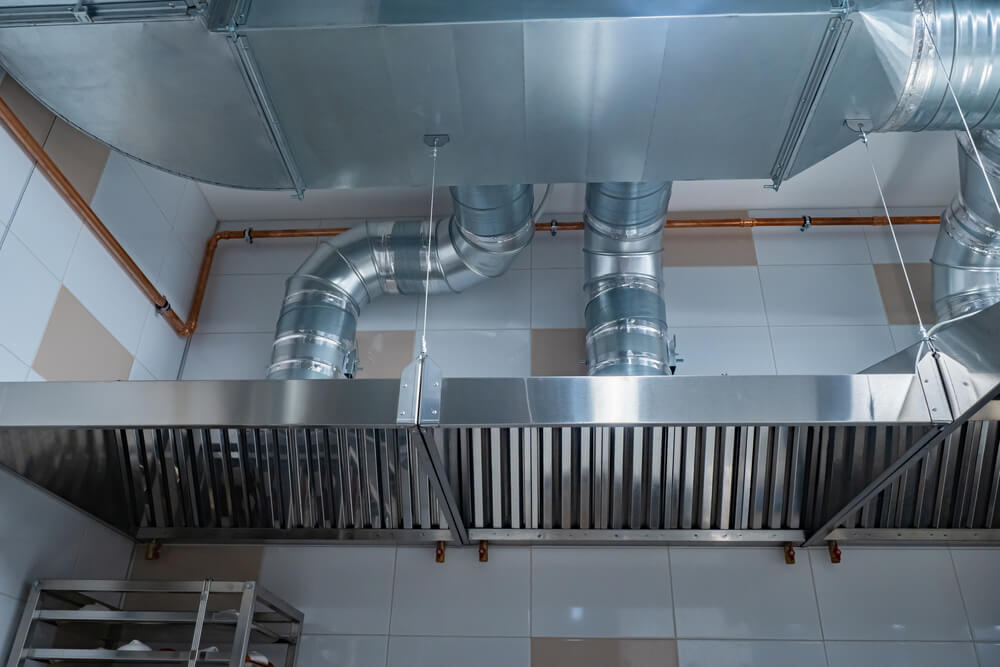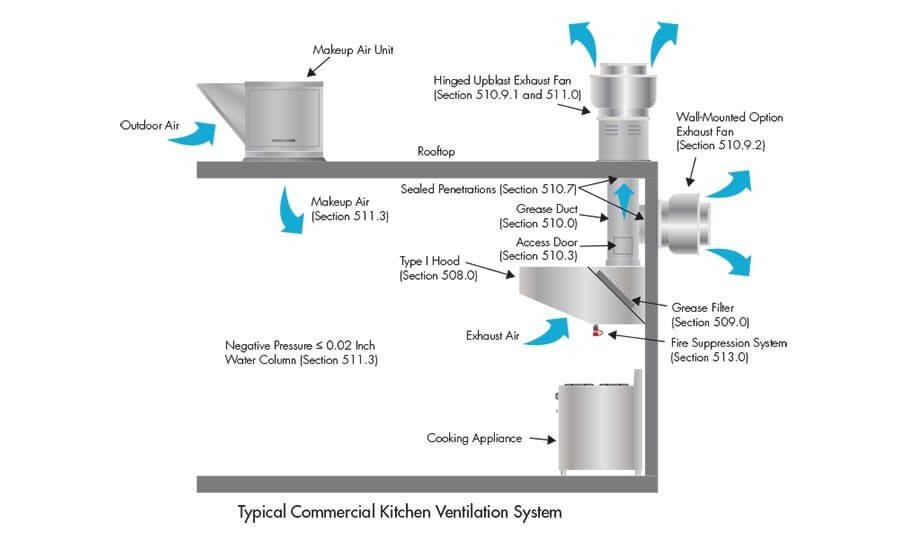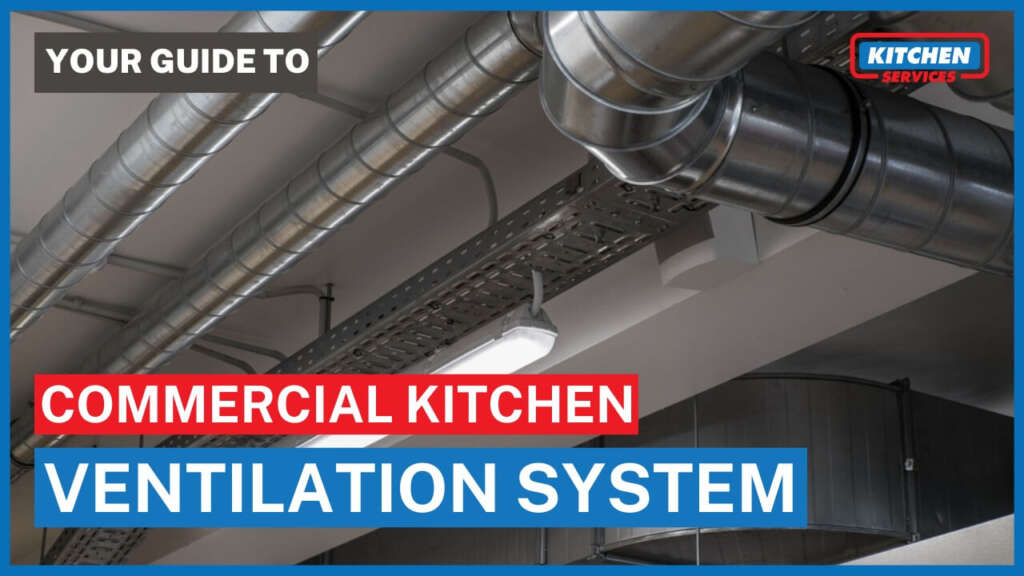We are all well aware of the fact that our commercial kitchen serves as the main part of any commercial cooking operation system. A lot of cooking takes place in all these commercial kitchens for the general public. Because of this large quantity of service and large-scale cooking companies need some proper design, construction, operation, and maintenance of ventilation systems. All these systems should be there as they can effectively manage grease vapors, odors, contaminants, and moisture that are there in the air, as well as poisonous and inflammable gases, such as carbon monoxide. In this guide, we will share the complete Commercial Kitchen Ventilation System for your restaurants.
When every component of a commercial ventilation system functions together agreeably in such an establishment, the whole system contributes to controlling the temperature, humidity, and airflow which then protects the patrons and employees by helping in improving the indoor air quality and minimizing possible dangers or risks.
The Right Way of Choosing the Hood Exhaust
When it comes to choosing the perfect size for your hood it might get really difficult sometimes. According to the International Mechanical Code, all the exhaust rates are based on the hood type and the appliance duty. Whereas the local codes determine overhang requirements. Your commercial restaurant design-build professional can really support you to make sure that you require a hood that will meet all your needs and that can satisfy all local regulatory requirements.
If you are looking for Commerial Kitchen hood Installation services in Santa Monica, Los Angeles and Beverly Hills, we at Kitchen Services, provide competitive price and high quality service. Not only that, we also provide commercial hood cleaning and repair . Besides cleaning and repair, we offer, Kitchen exhaust maintenance services for your commercial kitchen setup
The Different Styles of Commercial Hood Designs

Basically, commercial vent hood design is usually split into six main styles,
- Single Island Canopy: That is ceiling mounted that overhangs all fours sides of a single-aisle of your cooking equipment.
- Double Island Canopy: this one is ceiling mounted that overhangs all four sides of a double aisle of your cooking equipment.
- Wall Mounted Canopy: This one is wall mounted to the overhang with three sides of a single row of cooking equipment that is attached up against a wall.
- Back Shelf Hood: It can either be wall-mounted as well as free-standing, they are normally used above counter height equipment with the front overhang set back from the leading edge of the equipment that allows headroom for workers.
- Eyebrow Style Hood: This one is actually directly mounted to the leading edge of pizza and deck ovens.
- Pass-Over Style Hood: It is used for counter height equipment when a plate passing configuration from the cooking side to the serving side is needed.
Commercial Kitchen Ventilation Benefits

Commercial Kitchen Ventilation System is important for every commercial facility. Keep in mind that restaurants can be one of the very tricky environments to work in, kitchens are usually filled with smoke, odors, high heat, steam, and excess moisture. So, the proper ventilation in a restaurant can aid employees and customers with a lot of benefits such as:
Better indoor air quality
In any commercial kitchen no matter where it is, there is always going to be a considerable number of airborne pollutants, such as particulates, smoke, and grease as well. When you burn the fuel for your cooking purposes that may also produce very toxic gases like carbon monoxide etc.
Your proper Commercial Kitchen Ventilation System will surely help you in reducing all of these pollutants and will improve the overall acceptability of a restaurant kitchen. There is no chance that a ventilation system can take away all of the negative conditions in a busy restaurant, but effective ventilation will certainly keep the kitchen and food preparation areas much more comfortable for employees.
Cooling
It is obvious that your commercial kitchens are going to be hot no matter what, due to stoves, ovens, and every other equipment that is operating continuously, heat is one of the factors you can expect at any time in your kitchen. A good restaurant ventilation system can help you in providing cooling and can also reduce the temperature in your commercial kitchen by eliminating excess heat and bringing in a constant supply of cooler air from outside.
Reduction of odors
Where there is any food in making there has to be a different kind of odors that will be produced simultaneously, such as the basic smell of cooked food, overcooked or burned food, and the smell of raw ingredients as well. All of these odors mix up together and can produce a nasty combination in the kitchen and, from time to time, in the dining areas as well. Proper ventilation for commercial kitchen can surely help in removing these odors so that they do not have an effect on either the employees or even on the customers.
Elimination of grease
With these odors, grease is also a constant in any restaurant kitchen. It can make the air of your kitchen unpleasant and can coat walls, ceilings, floors, and equipment. All the commercial kitchen ventilation systems, particularly those that are designed for the removal of excessive grease, can help keep this substance out of the air and off the surfaces in your commercial kitchen.
Reduced costs
By reducing the heat in the kitchen with proper ventilation systems it will also reduce the need for cooling from an HVAC system. This will lower operating costs and overall energy bills as well.
Common Signs that your commercial exhaust fan needs repair
3 Tips to Ensure Maximum Ventilation in Your Commercial Kitchen

Necessary Ventilation
In your commercial kitchen, there must be a couple of ventilation you need to have to make sure things stay cool that is necessary ventilation and general ventilation. Your exhaust hood is actually the necessary ventilation. This has a system that captures and filters all of the heat, fumes, smoke, and other air particulates that are no more needed inside your commercial kitchen. Your kitchen vent hood is yet another very important element for your kitchen’s ventilation system. This one is normally attached to the top of your ovens. All these wall-mounted hoods are considered as a better option as opposed to the traditional overhead option for safety reasons.
The other element of necessary ventilation is makeup air. All the air is constantly exhausted outside of the restaurant at its full speed, so it is very much important for you to take a sufficient amount of air from outside at a rate of 80%. This is basically the makeup air it usually balances the exhausted air. If it is not there, it may cause very negative effects in your restaurant’s building like poor air quality, back-venting of combustible gases, drafty or stuffy areas, and reduced energy efficiency.
General Ventilation
Usually, the general ventilation system consists of systems that are not as important as exhaust hoods might be, but they are still considered helpful if the things are still a little too hot to handle.
The make-up air can usually come from a wide variety of sources such as a rooftop intake unit or properly screened doors and windows. General ventilation can be as simple as shutters on your commercial kitchen windows that are daily exposed to the full sunlight. It may also include opening doors and windows in the cool of the morning or late in the evening. Not only does this count as general ventilation, but also, it’s good cooling practice.
Air that goes out kitchen exhaust vents is replaced with a mix of make-up air from a variety of sources, including the dining room, a rooftop intake unit, or open doors or windows that are properly screened to prevent insects and other pests from invading food preparation areas. To reduce heat, shade, or shutter kitchen windows that are exposed to full sun. Open in the cool of the morning or later in the evening to let in the fresh air. If the kitchen is still too hot for everyone to handle, fans may be worth considering adding to your restaurant’s general ventilation.
You may have to experiment with placement to find that sweet spot for the best circulation. Fans should be aimed away from hot food and prep areas where lighter items could scatter. Auxiliary fans must not interfere with exhaust fans, either. You could consider using a floor fan with another propped on a steady surface above, such as the top of the refrigerator. However, or wherever you decide to use fans in your restaurant, make sure their blades and systems are kept clean and maintained as well.
HVAC
So, this is considered as one of the perfect ways to make sure that there is appropriate ventilation being circulated throughout the entire restaurant that is to combine it with an HVAC system. As we consider the kitchen as the heart of the restaurant, the other rooms like the dining room need to stay cool and consist of good air quality always.
Central air conditioning is going to be the best choice for your restaurant. Because you cannot use compact fans or window air conditioners around your hood vent system. Doing this can force hot, greasy air out from under the hood and distribute it to your dining room. There should be actually a 10-foot minimum to hood rule for air diffusers placed near a hood. This is why it’s best for any cooling system in a kitchen to be handled by a professional technician.
Conclusion
In conclusion, a well-designed ventilation system for restaurant kitchen is essential for maintaining a safe and efficient cooking environment. By ensuring proper airflow, controlling odors, and adhering to health and safety regulations, you can enhance the comfort and productivity of your kitchen. Regular maintenance and timely upgrades will keep your restaurant kitchen ventilation system functioning optimally, supporting a clean, compliant, and efficient kitchen operation.
Common FAQs about Commercial Kitchen Ventilation System
Can you have fans in a commercial kitchen?
One of the main commercial kitchen extraction regulations is the Workplace (Health, Safety and Welfare) Regulations 1992. This makes it a legal requirement for employers to provide ventilation in every enclosed workplace, including kitchens
What is kitchen ventilation?
Kitchen ventilation refers to the system of vents and fans used to remove or circulate air in a kitchen to maintain a safe and comfortable environment. It helps to remove smoke, steam, and odors produced during cooking and prevent the buildup of harmful gases such as carbon monoxide. Proper kitchen ventilation is crucial for maintaining good indoor air quality and preventing health issues
How to ventilate a kitchen?
Here are some points to ventilate a kitchen.
- Keep your kitchen windows open. Opening a window for ventilation is the easiest and most effective way to ventilate a kitchen.
- Install a kitchen vent fan for better ventilation.
Is kitchen ventilation required?
Though you may not be required to install a hood over your stove, it is generally recommended for the best cooking experience. Without one, smoke and fumes may build up in your kitchen. Range hoods also help to reduce heat and moisture while cooking.
Which type of vent system is used mostly for commercial kitchens?
Type 1 commercial hood systems are primarily used for the removal of smoke, grease-laden air, and byproducts of combustion. Almost all gas equipment will require a Type 1 hood, as will electric equipment that creates smoke during the cooking process.
How do you ventilate a commercial kitchen?
Ensure that the hood overhead fully covers the cooking appliance. Choose ceiling or wall-mounted exhaust hoods or vent hoods, where possible. Install exhaust hoods directly over cooking appliances where possible. Mount hoods as low as you can while still allowing easy access to the equipment for kitchen staff.

